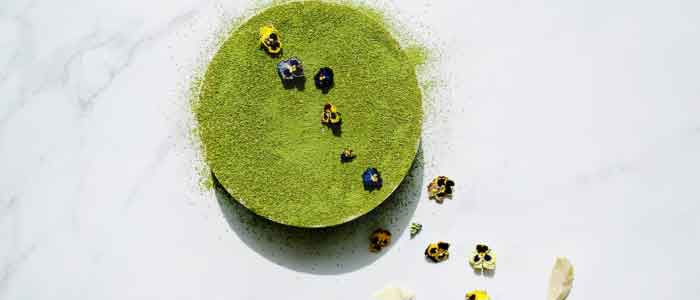Welcome to the vibrant world of matcha, a traditional Japanese green tea that’s more than just a beverage—it’s a cultural icon. At the heart of this green wonder is ceremonial grade matcha, the crème de la crème of matcha teas. Revered for its vibrant color, delicate flavor, and silky texture, ceremonial grade matcha is usually reserved for traditional tea ceremonies, where its preparation and consumption are elevated to an art form.
But here’s a thought: can this high-quality matcha make the leap from tea bowls to baking bowls? In this exploration, we’re going to dive into the intriguing possibility of using ceremonial grade matcha in baking. Can this esteemed tea grace our cakes and cookies with its exquisite flavor and color? Let’s find out!
Understanding Ceremonial Grade Matcha
So, what exactly is ceremonial grade matcha? Picture this: the finest, youngest tea leaves, handpicked with utmost care, then stone-ground into a fine, jade-green powder. That’s ceremonial grade matcha for you. It’s the elite among matcha varieties, known for its superior quality and exquisite taste. This isn’t your average supermarket tea; it’s a premium product that’s treated with reverence in Japanese tea ceremonies.
Now, let’s talk differences. Ceremonial grade matcha versus culinary grade matcha – what sets them apart? Think of it like wine; not all types are created equal. Ceremonial grade matcha is the top-tier, boasting a more vibrant color, a smoother texture, and a sweeter, more nuanced flavor compared to its culinary counterpart. Culinary grade matcha, while still good, is a bit more robust and astringent, making it better suited for recipes where it’s combined with other ingredients.
But why is ceremonial grade matcha usually the star of traditional tea ceremonies? It all boils down to its quality. In these ceremonies, matcha isn’t just a drink; it’s a symbol of hospitality, respect, and art. The subtle flavors and textures of ceremonial grade matcha are best appreciated in its purest form, without any additives. This allows the delicate nuances of the tea to shine, creating a moment of tranquility and reflection. In a ceremony steeped in history and ritual, only the best will do, and that’s where ceremonial grade matcha takes center stage.
Can You Use Ceremonial Grade Matcha for Baking Cakes?
The idea of using ceremonial grade matcha in cake baking might sound like a culinary extravagance, but it’s definitely possible and can be quite delightful. The key lies in its unparalleled flavor profile. Ceremonial grade matcha brings a delicate, sweet grassiness to cakes, a nuance that can be overshadowed when using stronger culinary grade matcha. However, there’s a balance to strike. The subtlety of ceremonial grade matcha means it can be easily overpowered by other ingredients, so it’s ideal for recipes where its gentle notes can really sing.
When considering using ceremonial grade matcha for cakes, think about two main factors: flavor and cost. This high-end matcha comes with a higher price tag, so using it in baking is a bit of a luxury. But for special occasions or when you want to create an extraordinary dessert, it can be worth the splurge. Additionally, the color is another point to consider. Ceremonial grade matcha imparts a more vibrant, appealing green hue to cakes, making them visually stunning.
For a quick recipe idea, why not try a simple ceremonial grade matcha sponge cake? You’ll need basic ingredients like flour, sugar, eggs, and butter, with the star being a couple of teaspoons of ceremonial grade matcha. The trick is to sift the matcha with the flour to ensure an even distribution and a uniform color. Remember, a little goes a long way with this high-quality matcha. The result? A cake that’s not only visually striking with its lush green color but also offers a delicate, refined flavor that’s sure to impress.
Can You Use Ceremonial Grade Matcha for Baking Cookies?
The thought of blending ceremonial grade matcha into cookie dough is a tantalizing one. In cookies, this exquisite matcha can add a touch of sophistication. Its fine texture and delicate flavor profile work surprisingly well in the cookie landscape. The ceremonial grade matcha melds beautifully with classic cookie ingredients, offering a subtle yet distinct taste that sets these cookies apart from their more conventional counterparts.
When it comes to adjustments in the recipe, using ceremonial grade matcha in cookies is straightforward but requires a gentle touch. Since this matcha is more refined and less astringent than culinary grade, you may want to use a little less than what a recipe might call for if it’s designed for the stronger-flavored culinary grade. Additionally, because of its delicate flavor, it’s best to pair it with ingredients that won’t overpower it. Think white chocolate chips or macadamia nuts, rather than more dominant flavors like dark chocolate or strong spices.
The visual appeal of ceremonial grade matcha in cookies is undeniable. These cookies will have a vibrant, inviting green color that is visually striking. And as for the taste, expect a nuanced flavor that’s both earthy and slightly sweet, with a whisper of the grassy notes for which high-quality matcha is renowned. It’s a unique taste experience that transforms a simple cookie into a gourmet treat, perfect for special occasions or as a luxurious everyday snack.
Best Matcha Powder for Baking
When it comes to baking with matcha, the debate between using ceremonial grade and culinary grade matcha is quite stirring. Ceremonial grade, as we’ve explored, is the epitome of matcha excellence, known for its fine texture and nuanced flavor. Culinary grade, on the other hand, is more robust and a tad more astringent, but it’s also more affordable and designed to hold its own against other ingredients in recipes.
Let’s weigh the pros and cons. Starting with ceremonial grade matcha, its pros include a superior flavor profile and a stunning, vibrant color. It’s perfect for recipes where matcha is the star. The cons? Price is the biggest factor. It’s more expensive, and its subtle flavors can be lost in recipes with dominant ingredients. Culinary grade matcha, meanwhile, is more budget-friendly and its stronger flavor can cut through other ingredients, making it great for more complex or richer baked goods. The downside is that it doesn’t offer the same delicate nuances and vibrant color as its ceremonial counterpart.
Recommendations for specific types of baking projects:
- Cakes: For delicate flavored cakes, such as a matcha sponge or chiffon cake, ceremonial grade matcha is preferable for its subtle flavor and color. If you’re making a richer, more flavorful cake where matcha is part of a broader palette of tastes, culinary grade is a better choice.
- Cookies: Culinary grade matcha is generally recommended because its stronger flavor can stand up to the baking process and other ingredients. However, for a more refined, subtle touch, ceremonial grade can be used in simple cookie recipes.
- Bread: For breads, culinary grade matcha is typically the way to go. Its robust flavor is a good match for yeasted breads and those with other strong flavors. If you’re experimenting with artisanal breads where matcha is a key flavor component, ceremonial grade might be used for an exquisite touch.
In the end, the choice between ceremonial and culinary grade matcha for baking hinges on the desired outcome in terms of flavor, color, and budget.
Considerations When Using Ceremonial Grade Matcha in Baking
Baking with ceremonial grade matcha can elevate your baked goods, but it’s essential to use it correctly to make the most of its delicate flavor and color. First, always sift the matcha powder before adding it to your dry ingredients to avoid clumps and ensure an even distribution. Since ceremonial grade matcha has a more subtle flavor, consider pairing it with lighter ingredients that won’t overpower it.
For instance, almond flour or vanilla can complement the matcha without masking its taste. Also, be mindful of the baking temperature; excessive heat can diminish the matcha’s vibrant color and delicate flavors. A lower baking temperature is often more suitable for preserving these qualities.
Proper storage and handling are crucial to maintaining the quality of ceremonial grade matcha. It should be stored in a cool, dark place, ideally in an airtight container to protect it from light, air, and moisture, which can degrade its quality. If you’re not baking regularly, consider storing your matcha in the refrigerator to extend its freshness. Remember to bring it back to room temperature before using it in your baking to ensure it blends smoothly into your recipes.
As for cost-effectiveness, using ceremonial grade matcha in baking is undoubtedly a luxury given its higher price point. If you’re experimenting or baking on a budget, consider starting with culinary grade matcha or a blend of both ceremonial and culinary grades. This approach allows you to still achieve a desirable matcha flavor and color in your baking, while being more economical. There are also some high-quality culinary grade matchas available that can closely mimic the delicate qualities of ceremonial grade, making them a practical alternative for regular baking.
Conclusion
To encapsulate our matcha-infused journey, we’ve delved into the unique world of ceremonial grade matcha and its role in baking. We’ve seen how its delicate, nuanced flavors can add a touch of elegance to cakes and cookies, and compared its characteristics with the more robust culinary grade matcha. We’ve also discussed the practical considerations of using ceremonial grade matcha in baking, from how to incorporate it into recipes to storing and handling it properly.
In closing, it’s clear that while ceremonial grade matcha is a more luxurious choice for baking, its exquisite flavor and vibrant color can truly elevate your baked goods. It offers a unique culinary experience, albeit at a higher cost. Whether you’re a seasoned baker or a curious novice, the world of matcha baking is rich with possibilities.
I encourage you to experiment with both ceremonial and culinary grade matcha in your baking adventures. Each has its own charm and can create different, delightful results. Whether you’re baking a light, fluffy chiffon cake or a batch of hearty cookies, incorporating matcha can transform your treats into something truly special. So, don your apron, preheat your oven, and embark on a flavorful journey with matcha!
Additional Resources
For those looking to dive deeper into matcha baking, there are numerous online resources filled with recipes and tips. Websites like Allrecipes and Epicurious offer a diverse range of matcha-infused baking recipes, from the elegant matcha green tea cake to playful matcha cookies and even matcha-flavored bread. These sites provide both beginner-friendly and more advanced recipes, allowing you to experiment at your own pace. For more comprehensive knowledge, consider exploring culinary books dedicated to Japanese cooking or specifically matcha-based recipes.
I’m also excited to invite you to share your matcha culinary creations with the world. Post your matcha baking adventures on social media with the hashtag #MatchaBakersUnite. Whether it’s a picture of your latest matcha masterpiece or a baking tip that made all the difference, your contributions can inspire and delight a community of matcha enthusiasts. Tag us in your posts, and let’s create a thriving, supportive network of matcha bakers, learning and growing together. Who knows, your unique creation might be the highlight in our next matcha-themed feature!


